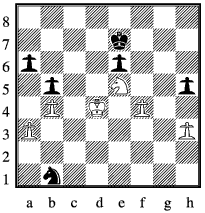
December 2016

|
| RR v James Fewkes after 63 ... Nc3b1 |
64 Kc5?? Nxa3, 65 Kb6 Nc2??, 66 Nd3 the counter blunder enabling white to hold both b and f pawns.
66 Kxa6 Nxb4+, 67 Kxb5 would also have been level. But
65 ... Kf6 and it becomes clear that the important feature of the postion is the proximity of the black king to the kingside pawns. It becomes apparent why abandoning the centre with Kc5 was a mistake.
Now
66 ... Kf6, 67 Kxa6 Nd4, 68 Kb6 Kf5, 69 Kc5 Ke4
70 Ne5 Ke3, 71 Nd7 Kd3, 72 Nf6 h4, 73 Ng4 sets the stage for the next blunder
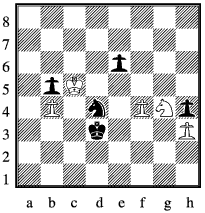
|
| RR v James Fewkes after 73 Ng4 |
73 ... Kc3, 74 Ne5 Ne2 Three blunders on the trot. Seeing how the game developed will reveal the nature of the errors.
75 Ng6 Ng1, 76 Nxh4 The final blunder. There is no hurry to take this pawn as with his own h-pawn destined to die RR creates no passed pawn. Equally if black takes on h3 first the moment he moves his knight again to release his pawn, it dies as the white knight no longer needs to defend the f-pawn. Kxb5 on the other hand would set up a march to victory with RR's own b-pawn, with black not having enough time for his knight to deal with both this and the h-pawn threats.
Had black played 74 Nc2 either the b-pawns are liquidated immediately or white plays Nc6 to protect his own b-pawn, giving black's king the chance to eat the f and h pawns and sac his knight for the b-pawn to secure the draw. For white
73 Ne3 would have thwarted this plan and then set up multiple threats as in the game except with his knight on g2 instead of g6.
Back at the game, events unfolded
76 ... Nxh3, 77 Ng6 Nf2, 78 Kxb5 Nd3 79 Ka5 1/2-1/2 it being clear that all the pawns will be swept up.
Yes, we could have shaken hands on a draw much earlier, but as we both showed it is remarkably easy to go wrong in endgames. Play the game out and (hopefully) learn from the mistakes is surely a better long-term strategy, unless you are more interested in racking up draws to maintain your grade.
comment on this article
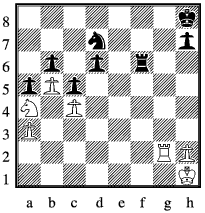
|
| Stephen Williams v RR after 39 ... Rxf6 |
40 Rd2 Kg7, 41 Kg2 Kf7, 42 Nc3 deciding to centralise his knight, but freeing RR's too.
42 ... Ne5, 43 Ne4 Rg6+, 44 Kf1 picking a square on which the king cannot be checked ...
44 ... Nxc4 ... but now the rook cannot hit the black knight from c2 because of the resultant fork on e3
45 Rd3 d5, 46 Rxd5 oops Ne3+ ouch 0-1
comment on this article
1 Nf3 e6, 2 c4 d5, 3 e3 Nf6, 4 b3 Be7, 5 Bb2 O-O
6 Be2 c5, 7 O-O Nc6, 8 cxd5 Nxd5, 9 d4 cxd4, 10 Nxd4 Nxd4
11 Bxd4 Bf6, 12 Qd2 Bd7, 13 Na3 Bc6, 14 Rac1 Bxd4, 15 Qxd4 Qf6
16 Qxf6 Nxf6, 17 Rfd1 Rfd8, 18 f3 Kf8, 19 Kf2 Ke7, 20 Nc4 Rxd1
21 Rxd1 Nd5, 22 Ne5 Be8, 23 Rc1 Kd6, 24 f4 f6, 25 Nf3 Bg6
26 a3 Rd8, 27 g3 Rd7, 28 Nd4 Ke7, 29 Bg4 Rc7, 30 Rxc7+ Nxc7
31 Bf3 Nd5, 32 e4 Nc3, 33 Ke3 e5, 34 Nf5+ Bxf5, 35 exf5 exf4+
36 Kxf4 b5, 37 Ke3 Nb1, 38 a4 bxa4, 39 bxa4 Nc3, 40 a5 Kd6
41 Kd4 Nb5+, 42 Kc4 Nc7, 43 Kd4 1/2-1/2
comment on this article
We join proceedings for RR's tenth move.
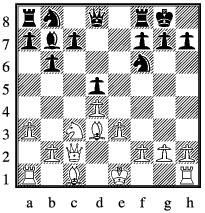
|
| Yasser Tello v RR after 10 Bd3 |
10 ... h6, 11 b4 Did I really allow him to play that? Whoever is operating my brain should be sacked. I've happily played the white side of similar positions many times, and I don't particularly fancy a game in which I sit passively whilst Yasser slowly strengthens his grip. Still his king is in the centre, so he'll probably be (justifiably) averse to having too much action before castling.
11... c5, 12 bxc5 bxc5, 13 O-O As suspected. dxc5 is better according to a reliable second opinion, as is Rb1, but in either case options proliferate, with some being very unpleasant for one side or the other. Opting to retain some control in the position is a pragmatic decision.
13 ... c4, 14 Bf5 Nc6, 15 Rb1 Bc8, 16 Bd2 Bxf5, 17 Qxf5
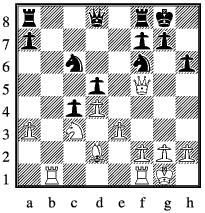
|
| Yasser Tello v RR after 17 Qxf5 |
17 ... Ne7, 18 Qc2 Qd7, 19 e4 dxe4, 20 Nxe4 Qxd4 Apparently keeping some central pawns on with
20 ... Nxe4, 21 Qxe4 Nd5 favours black, certainly his remaining knight would be an annoyance to white.
21 Nxf6+ Qxf6, 22 Qxc4
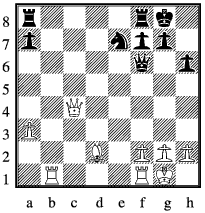
|
| Yasser Tello v RR after 22 Qxc4 |
22 ... Rfc8 The wrong rook as
23 Qe4 stops the c-rook advancing as it is needed to defend his partner
23 ... Nf5, 24 Rfc1 Nd4, 25 Rxc8+ (Bc3 Ne2+ removes the minor pieces, making the position more sterile as the sides have identical forces at their disposal.)
25 ... Rxc8, 26 h3 Ne6 No. Should take the opportunity to get the a-pawn off a black square.
27 Be3 Ng5, 28 Qg4 Ne6, 29 a4 Rc7, 30 a5 Kh7 31 Qe4+ g6 Having missed multiple chances to advance his own pawn, the white a-pawn is now becoming menacing, so RR no longer wishes to offer an exchange of queens with Qg6.
32 Qa8 The black a-pawn is certainly not long for this world
32 ... Rd7 at least this is a white square and threatens a white square on the enemy back rank.
33 Bxa7 There goes the pawn, but temporarily I have almost the run of the centre. Time for a fork:
33 ... Qf5
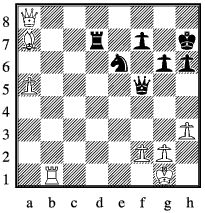
|
| Yasser Tello v RR after 33 ... Qf5 |
34 Ra1 He'll be sorry.
34 ... Qe5 Now moving the rook forwards allows mate, sideways loses the pawn and bishop.
35 Bd4 Nxd4, 36 Rb1 Qf5 Possibly not the most powerful continuation, but it should be a case of all sensible choices win from here.
37 Rb8 An attempt to generate counter play, but its too late:
37 ... Ne2+, 38 Kf1 (38 Kh2 Qf4+) Rd1+, 39 Kxe2 Qd3# 0-1
comment on this article

|
| RR v Richard George after 17 ... c5 |
18 Ne2 Bd3 a pin, 19 Rf2 Qc6, 20 Rc1 another pin
20 ... Rc8, 21 Nd4 using the pin Qc7, 22 Ba5 pin!
22 ... c4, 23 h3 Slow. Escape squares for kings are all well and good, but it is black who has the luxury of building pressure as he wishes. Rb2 is more active, or if he can't persuade himself to bring more across to the queenside, RR should open a line of attack with f5.
23 ... Qb7, 24 Qd6 Rab8, 25 Rb2 Too late, attracting
25 ... Na4 making use of the pinned pawn to reach better squares
26 Rd2 Nc5, 27 Kh2 failing to spot the continuation Ne4 Fork
Its all gone pear-shaped. 0-1
comment on this article
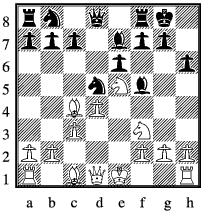
|
| Malcolm Roberts v RR after 9 Nd2f3 |
10 Nd3 Nb6 A waste of time. The logical continuation, justifying f6, would have been g5, but fear of death stops me from calculating the consequences of h4 with any certainty.
11 Bb3 Nd5 The e-pawn is just too weak to be allowed to be under direct attack from the bishop. If RR plays something else and white selects Nh4, now what. Perhaps it means the sensible ploy would be to abandon the pawn and look for activity (where?)
12 h3 Qd6 If you have to shore up the defence of pawns with the queen you know you're in trouble.
13 O-O Nc6, 14 a3 Kh8 Malcolm has just taken a square away from the d5 knight should b4 be played, surely time to pay attention to that threat.
15 Re1 b5 Paying attention to the threat, but very loose. Qd7 must be better.
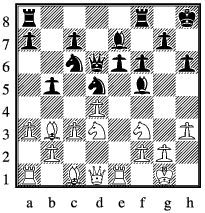
|
| Malcolm Roberts v RR after 15 ... b5 |
19 Qxc2 Rf7, 20 Ng6+ Kg8, 21 Qe4 f5, 22 Qe2 Rf6, 23 Ne5 Nb6 To prevent Ncd7 winning the exchange.
24 Qxb5
A pawn drops, but the pressure doesn't. RR tries digging in, but it merely prolongs the agony. 1-0
comment on this article
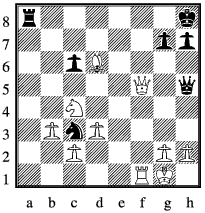
|
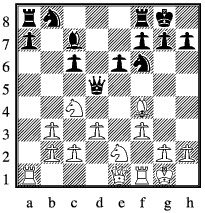
|
| Dave Risley v RR after 16 Bc1f4 |
17 ... Qc5+, 18 Be3 reducing the pressure on e5, but skewering through to the a-pawn
18 ... Qe7, 19 Rxa7 Rxa7, 20 Bxa7 All of this RR should have seen before playing e5, but didn't. Now he finds himself a second pawn down, with the e5 move also having reduced his bishop to a spectator.
20 ... Ba5 How clever - a pin and a discovered attack in one move. You'd almost think RR had played this game before.
21 Qf2 (Bd4 and the e-pawn goes too)
21 ... Bxc3, 22 bxc3 Nbd7, 23 Be3 Nd5, 24 Bd2 Ra8A consolation prize. RR has the empty file. Maybe there'll be a back row mate.
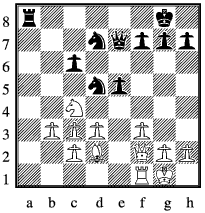
|
| Dave Risley v RR after 24 ... Ra8 |
25 ... exf4, 26 Bxf4 Nxc3, 27 Bd6 Qe2 RR spotted the threat to the queen from the bishop (small mercies), but was blithely unaware of the threat against f7. And he can't even claim a hangover from a Christmas party as an excuse.
28 Qxf7+ Kh8, 29 Qxd7 Oh look, I've lost a piece. Be5 is coming, and I really don't want to take my rook off the a-file, so the queen is going to have to come back.
29 ... Qh5, 30 Qf5 which brings us to the position at the the start of the article. Haha! I can win his queen.
30 ... Ne2+, 31 Kh1 Ng3+ forking king and queen with the h-pawn pinned
32 Bxg3 Where did that come from. If I can't even see the bishop taking the knight there is no point in continuing. Resigns. Failing to spot that even now Qxf5 gives black an advantage, though not as great as had he taken it after the first knight check. Why was it RR wanted to keep the rook on the open a-file? A spectator might have said that black was determined to lose this game, and if necessary was prepared to resign in order to do so. Still at least his team mates piled up the points so the match was won.
So the curtain came down on RR's efforts for 2016 like a guillotine to his neck. Fingers crossed that this is as bad as it gets.
| Dave Risley: |
I read your article on our game with interest.
Here are a few comments: You seem to have been distracted from your previous idea of a back rank mate with the rook by the idea of the knight fork winning the black queen. I seem to have suffered similar confusion. I'll explain what I was thinking in the run-up to the mutual blunders.
After I grabbed the black knight with 29 Qxd7 (and it's not the best move anyway: 29 Be5 is best) I was wondering about grabbing the c6 pawn next move but thought that would be a bit greedy. John Nunn in Secrets of Practical Chess promotes the acronym LPDO (loose pieces drop off). I am aware that by shifting my queen off the f-file the white rook now only has the king to protect it and it might end up in some variations unprotected. I have the vague idea when I play 30 Qf5?? that I am getting all the pieces protecting each other. So, hey, forget about 30 Be5. I can pop back to the f-file with the queen, connect the major pieces, threaten a back rank mate and offer a queen swap. If you take the queen I recapture with the rook and the back rank's ok because I can play Kf2 when you check.
So much for white‘s blunder. What about black's blunder? After 32 Bxg3 the shock was so great you resigned almost immediately. In the Secrets book Nunn has some comments relevant to such blunders. 'The most common cause of blundering is a previous oversight ... A typical train of thought starts: Oh, ****! I completely overlooked that. It looks strong: perhaps I will even have to resign. How could I have overlooked such a simple idea?' Nunn advises, when your opponent makes a move you hadn't considered, 'take the time necessary until one's mind and stomach have quietened down'. Good advice but how often have I (for one) failed to follow it! |
| RR: |
Thanks for your comments Dave. It is always interesting how the two players can view a position differently. Here we have the less common situation in which both players were labouring under the same illusion, namely that on f5 the queen is protected by the rook. Nunn's comment that The most common cause of blundering is a previous oversight rings true, with the confidence sapping earlier oversight leading at best to more superficial subsequent analysis and at worst the distracting analysis of what might have happened had the earlier oversight not occurred. Ideally the oversight would act as a wake-up call (OK, ideally the oversight would not have been made), but as one piles on another you reach the stage where you're willing to believe you can do no right. Nunn's advice: take the time necessary until one's mind and stomach have quietened down is clearly sound, but requires one to be totally in control of one's emotions regardless of one's appalling play. For me at least, that is easier said than done. Perhaps more than anything this game is a classic example of players knowing more than they can consistently put into practice, and that arguments like "I'm too good a player to make a mistake like that" are merely respect-preserving delusions. |
Division 1
| ||||||||||||||||||||||||||||||||||||||||||||||||||||||||
Division 3
| ||||||||||||||||||||||||||||||||||||||||||||||||||||||||
Division 5
|
Division 2
| ||||||||||||||||||||||||||||||||||||||||||||||||||||||||
Division 4
|
As ever postponements have given some of the league tables a rather lop-sided look. By my reckoning there were 18 postonements from the 99 scheduled pre-Christmas matches. Of these six have already been played and one, in a cup, conceded. Only two of the other eleven appear to have had new dates agreed. There has also been one match brought forwards from an after Christmas date and played. With just one board defaulted, and one extra board played in a division five match, 376 boards have been sent for grading.
A couple of postponements have meant a slow start to division one, so what have the rest of the league missed by not participating? Stafford's quintet had a total grade of 936, Cheddleton's two teams averaged 899, Newcastle's side weighed in every time at 827 and Holmes Chapel have averaged 822. That's quite a jump up from division two where the limit is 725.
You could throw a handkerchief over the division two teams. Two are currently on par, two at +1 and two at -1 as they near the half-way point. Predicting who will be on top of this pile when the music stops is definitely a mug's game.
It won't last. Newcastle D have the only 100% record outside of division one, so I guess that I'll have to install them as current favourites despite being captained by RR. There are plenty of dangerous matches left however. Meir's five points have come in their last three matches, having started with four straight defeats. All bar Newcastle will be hoping that the leaders do a reverse Meir. Meir's revival means that the race to prop up the rest appears to be a straight fight between Kidsgrove and Crewe.
Cheddleton E have opened up an enormous lead at the top of the fourth, leaving the others in a separate race for second in which only Alsager B are struggling to participate.
"Why always us?" is the plaintiff cry from Cheddleton I against whom other teams have been postponing. They've still managed one point more than stablemates the H team. With both matches between the pair yet to be played the table may give a false impression of how far they are adrift. The top end of the table is developing into an interesting contest between Cheddleton G, Crewe D and the C teams of Fenton and Meir. Currently its too close to call, but I'll stick my neck out and put my money, all one penny of it, on the present leaders.
Fenton and Meir were the biggest losers in the preliminary round of the cups, each losing two sides. The semi-final draws are dominated by Cheddleton and Newcastle who appear in all four cups at this stage, and Crewe who are in three. Alsager, Fenton, Holmes Chapel, Keele University and Stafford each fill one of the remaining slots. However there is only one clear favourite, Cheddleton in the major cup since they have much more strength in depth than the other clubs at that level.
There was no Leek Congress this year to act as a pre-season warm-up, but Crewe put on an excellent event in mid-October, when many will claim they were still in pre-season condition. There was also significant North Staffs presence at Preston at the beginning of December, and the entry lists suggests there will be a significant turn out at Telford in January.
Holmes Chapel hosted the doubles again in December, with Jon Blackburn and daughter Suzy Cooke winning the upper section and Alberto Gissi and Michael Lee taking the lower one.
Simon Edwards is again leading a Cheddleton branded team in the 4NCL division three north where they again meet Holmes Chapel.
Peter Windows has been the most active player in league and cup, having turned out fifteen times for Meir. The unlucky runners-up in that race are Doug Barnett (Crewe), Dave Rose (Cheddleton) and Alberto Gissi (Newcastle) all on thirteen. All told 148 players have shown their faces, 75 of whom have done so sufficiently frequently to have a performance reported on my perfs page.
Joshua Brown leads the outperformance stakes by a country mile, his performance of 115 against a grade of 40 is an outperformance of 75. Next up is George Scattergood (Holmes Chapel) with an outperformance of 33. Reinhold Heinlein (Newcastle), Neville Jones (Alsager), John Yee (Cheddleton), Ray Rhodes (Meir) and Kas Capatina (Fenton) complete the list of those outperforming by at least twenty. I wonder how many of these will have suffered mean reversion by the end of the season.
That's it. I've run out of facts, figures and opinions to bore you with. I am intending to hold another mini, probably in March, but I'm yet to agree a date with the Bridge Club. Best wishes for the new year, except when playing Newcastle in general and me in particular!
comment on this article